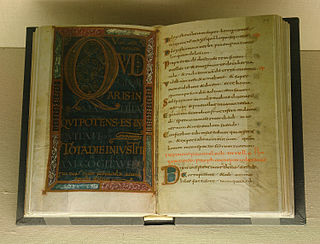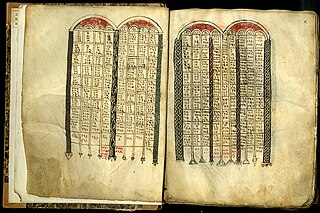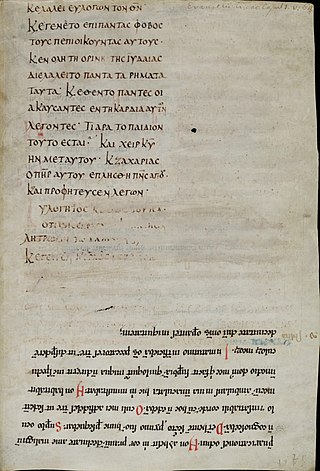Related Research Articles

Lobegott Friedrich Constantin (von) Tischendorf was a German biblical scholar. In 1844, he discovered the world's oldest and most complete Bible dated to around the mid-4th century and called Codex Sinaiticus after Saint Catherine's Monastery at Mount Sinai, where Tischendorf discovered it.

The Codex Sinaiticus, designated by siglum א [Aleph] or 01, δ 2, or Sinai Bible is a fourth century Christian manuscript of a Greek Bible, containing the majority of the Greek Old Testament, including the Apocrypha along with the deuterocanonical books, and the Greek New Testament, with both the Epistle of Barnabas and the Shepherd of Hermas included. It is written in uncial letters on parchment. It is one of the four great uncial codices. Along with Codex Alexandrinus and Codex Vaticanus, it is one of the earliest and most complete manuscripts of the Bible, and contains the oldest complete copy of the New Testament. It is a historical treasure, and using the study of comparative writing styles (palaeography), it has been dated to the mid-fourth century.

The Vulgate, sometimes referred to as the Latin Vulgate, is a late-4th-century Latin translation of the Bible.

The Codex Vaticanus, designated by siglum B or 03, δ 1, is a fourth-century Christian manuscript of a Greek Bible, containing the majority of the Greek Old Testament and the majority of the Greek New Testament. It is one of the four great uncial codices. Along with Codex Alexandrinus and Codex Sinaiticus, it is one of the earliest and most complete manuscripts of the Bible. The codex has been dated palaeographically to the 4th century.

The Cotton Genesis is a 4th- or 5th-century Greek Illuminated manuscript copy of the Book of Genesis. It was a luxury manuscript with many miniatures. It is one of the oldest illustrated biblical codices to survive to the modern period. Most of the manuscript was destroyed in the Cotton library fire in 1731, leaving only eighteen charred, shrunken scraps of vellum. From the remnants, the manuscript appears to have been more than 440 pages with approximately 340-360 illustrations that were framed and inserted into the text column. Many miniatures were also copied in the 17th century and are now in the Bibliothèque nationale de France in Paris.

The Codex Ephraemi Rescriptus designated by the siglum C or 04, δ 3, is a manuscript of the Greek Bible, written on parchment. It contains most of the New Testament and some Old Testament books, with sizeable portions missing. It is one of the four great uncials. The manuscript is not intact: its current condition contains material from every New Testament book except 2 Thessalonians and 2 John; however, only six books of the Greek Old Testament are represented. It is not known whether 2 Thessalonians and 2 John were excluded on purpose, or whether no fragment of either epistle happened to survive.
The Book of Odes, also known as the Biblical Odes, refers to a collection of hymns and prayers referencing the Bible and used as a part of Liturgy in some denominations. The biblical odes form the basis for the Eastern Orthodox canon sung during matins and other services.

There exist a number of translations of the Book of Psalms into the Latin language. They are a resource used in the Liturgy of the Hours and other forms of the canonical hours in the Latin liturgical rites of the Catholic Church.

Codex Boernerianus, designated by Gp, G3 or 012 (in the Gregory-Aland numbering of New Testament manuscripts), α 1028 (in the von Soden numbering of New Testament manuscripts), is a small New Testament manuscript made of parchment which contains the majority of the Pauline epistles. Using the study of comparative writing styles (paleography), the manuscript has been dated to the 9th century CE. The name of the codex derives from the theology professor Christian Frederick Boerner, to whom it once belonged. The manuscript has several gaps.

Codex Vaticanus, designated by S or 028, ε 1027, formerly called Codex Guelpherbytanus, is a Greek manuscript of the four Gospels which can be dated to a specific year instead of an estimated range. The colophon of the codex lists the date as 949. This manuscript is one of the four oldest New Testament manuscripts dated in this manner, and the only dated uncial.

Codex Augiensis, designated by Fp or 010, α 1029 is a 9th-century diglot uncial manuscript of the Pauline Epistles in double parallel columns of Greek and Latin on the same page.

Codex Cyprius, designated by Ke or 017, ε71, or Codex Colbertinus 5149, is a Greek uncial manuscript of the four Gospels, written on parchment. It is one of the few uncial manuscripts with the complete text of the four Gospels, and it is one of the more important late uncial manuscripts. It was brought from Cyprus to Paris.

Codex Tischendorfianus III – designated by siglum Λ or 039, ε 77 – is a Greek uncial manuscript of the Gospels on parchment. Palaeographically it has been assigned to the 9th or 10th century.
Uncial 066, α 1000 (Soden), is a Greek uncial manuscript of the New Testament. Palaeographically it has been assigned to the 6th-century.
Codex Tischendorfianus I, designated as Uncial 0106, ε 40 (Soden), is a Greek uncial manuscript of the New Testament on parchment. It is dated palaeographically to the 7th century. The manuscript is fragmentary.

Uncial 0130, ε 80 (Soden), is a Greek uncial manuscript of the New Testament, dated palaeographically to the 9th-century. Formerly it was labelled by Wc.
Lectionary 135, designated by siglum ℓ135 is a Greek manuscript of the New Testament, on parchment leaves. Palaeographically it has been assigned to the 8th century.

Codex Marchalianus designated by siglum Q is a 6th-century Greek manuscript copy of the Greek version of the Hebrew Bible known as the Septuagint. The text was written on vellum in uncial letters. Palaeographically it has been assigned to the 6th century. Marginal annotations were later added to the copy of the Scripture text, the early ones being of importance for a study of the history of the Septuagint.

The great uncial codices or four great uncials are the only remaining uncial codices that contain the entire text of the Bible in Greek. They are the Codex Vaticanus in the Vatican Library, the Codex Sinaiticus and the Codex Alexandrinus in the British Library, and the Codex Ephraemi Rescriptus in the Bibliothèque nationale de France in Paris.

Vetus Latinamanuscripts are handwritten copies of the earliest Latin translations of the Bible, known as the "Vetus Latina" or "Old Latin". They originated prior to Jerome from multiple translators, and differ from Vulgate manuscripts which follow the late-4th-century Latin translation mainly done by Jerome.
References
- ↑ Henry Barclay Swete; Henry St. John Thackeray (1900). An Introduction to the Old Testament in Greek: With an Appendix Containing the Letter of Aristeas. Cambridge University Press. pp. 142–. ISBN 978-1-108-00758-0.
 This article incorporates text from this source, which is in the public domain .
This article incorporates text from this source, which is in the public domain . - ↑ Thomas Hartwell Horne (1822). Supplementary pages to the second edition of An introduction to the critical study and knowledge of the holy Scriptures. T. Cadell. pp. 486–.